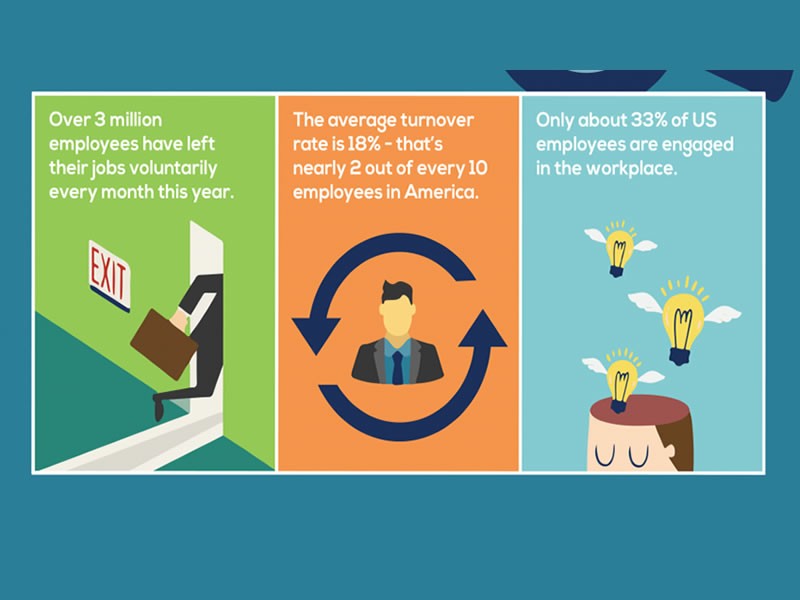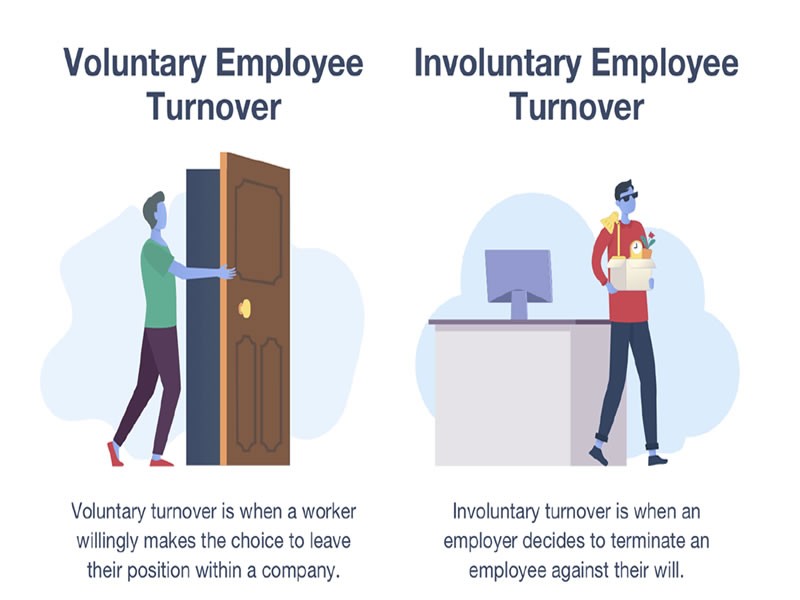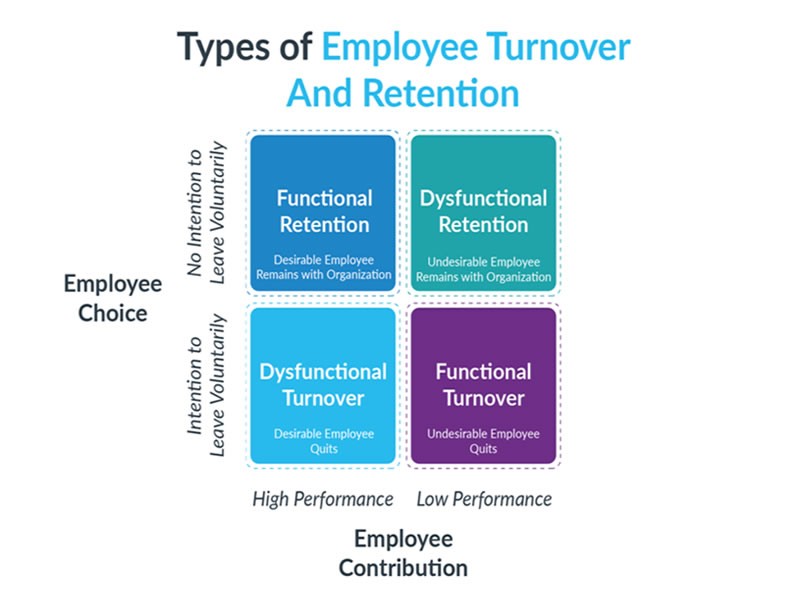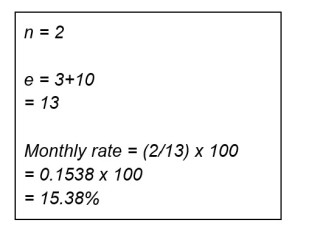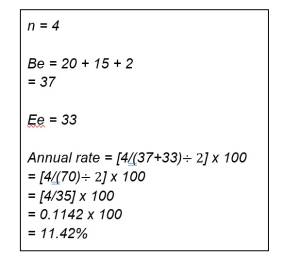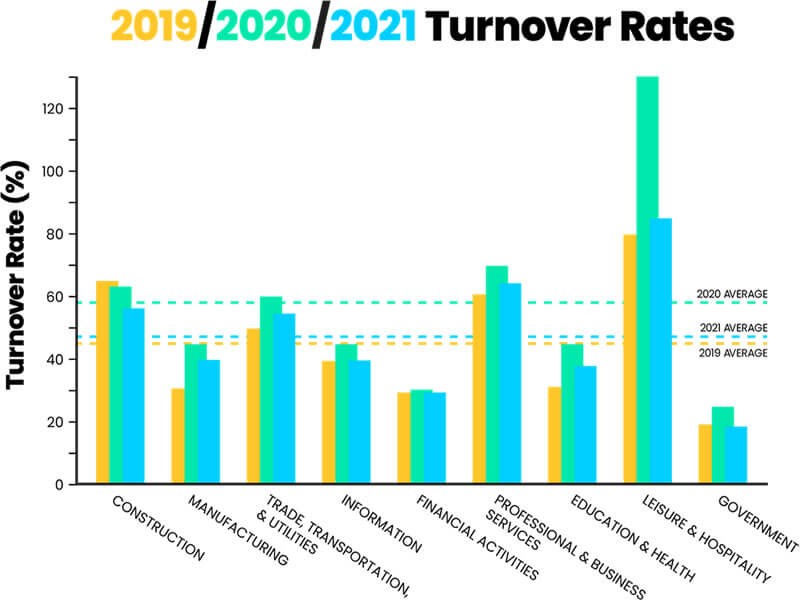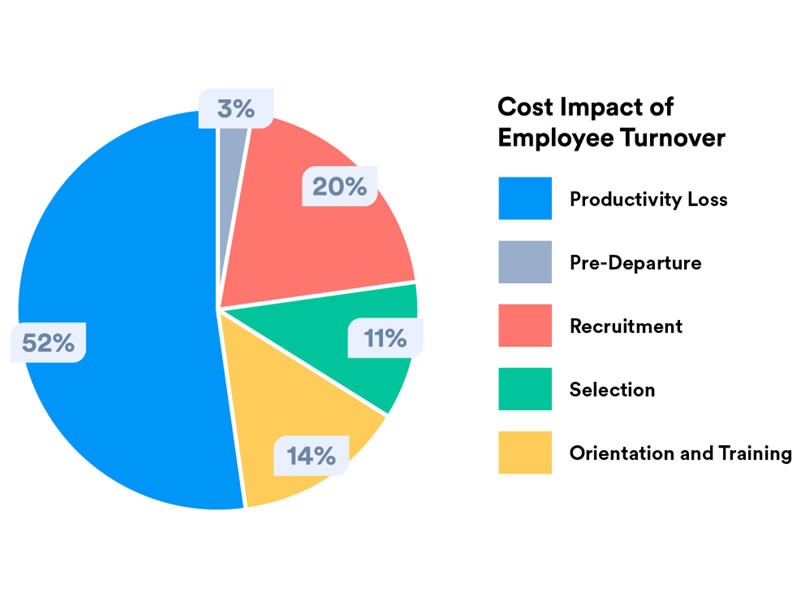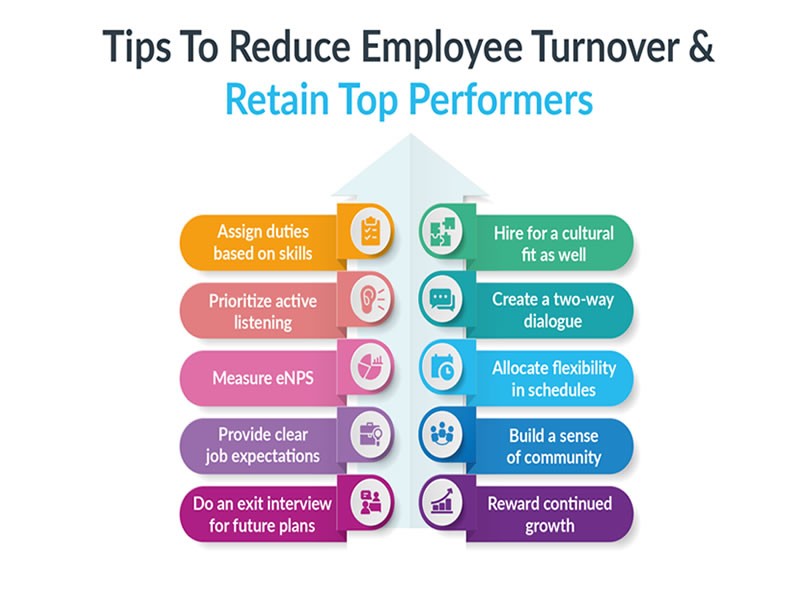Insight Blog
Agility’s perspectives on transforming the employee's experience throughout remote transformation using connected enterprise tools.
14 minutes reading time
(2787 words)
Featured
How To Calculate Turnover Of Employees - A Complete Guide
Calculating turn of employees is important, however how do you obtain your monthly turnover percentage?
Nothing hurts businesses more than employees joining their ranks and leaving all the same. Employers make every effort to keep their workers. But despite the extra resources, complications can arise at any stage of the employment process. Companies of all scales need to know how to calculate turnover and find solutions to reduce its impact.
Recruiting the right person for any job isn't simple. And it can be particularly tough to retain your best employees with new opportunities and fancier paychecks at every corner. To help deal with this, most companies have to invest heavily in human resource departments to shoulder the burden.
Our blog today is the ideal place to understand what the employee turnover rate is, how you can calculate it for your company, and the measures to keep it at an all-time low. By the end of this article, we hope your business can keep the top talent you've worked hard to recruit.
What Is Employee Turnover?
Employee turnover refers to the calculation of the average number of employees that quit or leave a company in a specified time frame. This period is usually 6 months to 1 year in most firms. In essence, the employee turnover rate is the opposite of the employee retention rate.
This rate can also apply to specific departments in a company or certain demographics, such as age, gender, and overall professional experience of the individual.
Not all employee turnovers are the same, and the two most prominent types are…
a. Voluntary Turnover
It is the specific instance where an employee contracted by a company chooses to leave or resign for any number of reasons. These reasons could be a result of a better job opportunity elsewhere, disagreements and conflicts in the workplace, or any other.
b. Involuntary Turnover
Involuntary turnover refers to the instance when the employer chooses to terminate the employment contract for any reason. These reasons could be related to:
- Corporate theft
- Policy breaches
- Improper conduct
- Poor performance
Companies typically reserve terminations unless employer-employee relationships are at a severing point, and maintaining the current individual or department does not make sense anymore. Employers can demand resignations too, which would be classified as involuntary turnover.
How To Calculate Turnover Of Employees?
If you run a company or are thinking of hiring new employees for your startup, metrics such as staff turnover and employee retention are vital for your continued success. These will help in identifying retention benchmarks for your company and highlight any potential issues before they rear their ugly heads.
Companies can also develop an undesirable reputation among many in the workforce if it consistently has a high turnover rate. Prospective job seekers are wary of companies that don't retain their employees for long periods and aren't keen to work in an environment where job security is always compromised.
Sometimes a particular company or a sector gets this tag because of the elements that are beyond its control. This happened to many companies in the aviation industry during the pandemic.
Air travel across the world came to a standstill and airlines and their partnering firms, particularly the platforms offering cheap flight deals were the most affected ones. These companies had no control over this, yet it nonetheless contributed to the industry's reputation for having low job security.
In essence, this is the biggest issue companies face since most job seekers assume a high turnover is almost exclusively due to the company's failure at meeting employee requirements when the issues could be entirely inverse. It can ultimately lead to frustration in the HR department where resources can struggle to find long-term employees to fill roles.
Human resources also jeopardize their time and efforts in onboarding recruits that do not stick around to put their investment into productive hours. Wasted efforts ultimately harm the company with the cost of turnover not being the easiest expense to swallow for most executives. It is therefore vital to learn how to calculate this vital metric for your business.
A. Monthly Turnover Calculation
Monitoring the monthly employee turnover rate is beneficial for companies looking to chart the trend with various data points. Monthly record keeping can help provide a clearer perspective on why your employees are leaving so soon and can provide historic and reliable data on the subject.
With this data, you can gauge the turnover across all the departments and see if the issue is specific to one particular department or is plaguing all of them equally. A thorough study of this vital data will assist in identifying the key problems and helping you to strategically plan your hiring practices and streamline HR processes.
Here is the turnover rate formula for calculating the monthly employee turnout rate:
Here, "n" is the number of people that separated in the month, and "e" refers to the total number of employees at the company during the month. Include voluntary, involuntary, and retirements when calculating "n".
Divide the two values and multiply the result by 100 to get your company's turnover rate for the month.
Let's look at an example:
You started a business that specializes in building mannequins for retailers across the state. Your manufacturing plant requires 10 on-site people for molding and casting and 3 for sewing and assembly. You filled in the vacant spots and 2 employees resigned within the probationary period. Here's how the calculation works out.
B. Annual Turnover Calculation
Monthly rates may be a good indicator but can be an added task for the HR department to keep track of. Plus, most companies may not have an urgent need to address the turnover issue and are happy charting out data points every year. Their preference can also be determined by the patterns taking a long time to emerge, and a quarterly or annual turnover rate may be the best indicator.
Nevertheless, here is how you can begin calculating your company's annual employee turnover rate:
Sounds complicated, right? Here, "n" is the number of separations in the month, "Be" refers to the total number of active employees at the company during the start of the year, and "Ee" refers to the number of employees left at the company towards the end of the year. Include voluntary, involuntary, and retirements when calculating "n".
Let's work through it with an example of an online store for a clearer understanding.
A platform selling health and wellness products, kids' facemasks, and other similar products require 20 digital marketing experts, 15 customer support agents, and 2 programmers all year round. The company parted ways with a software developer in June, a senior SEM executive in August, another in September, and a final before Christmas.
This is how the company would calculate its employee turnover rate for the year:
What Is A Healthy Employee Turnover Rate?
The percentages are essentially meaningless unless you have a lot of data points that are charted and recorded over a long period. Still, while calculating the rate can provide you with an exact value of exit interviews and separations, without an appropriate benchmark, you wouldn't know if you should panic or not.
Some industries naturally have a high employee turnover because of various reasons. This pattern is most commonly found in factories that employ hundreds for menial tasks. Poor working conditions, a lack of job security, and low salaries are all big contributors too.
Similarly, high-level corporate positions and companies with high employee satisfaction levels are assumed to have a low turnover rate.
Going by industry and geography can be a great barometer for gauging the correct and appropriate turnover rates for your business.
I. Information Technology (IT)
Due to intense competition from every country in the world, a high attrition rate consistently plagues the IT industry. From web development companies to SEO service providers, everyone wants the best talent. And for the larger Silicon Valley-based companies, prizing them away on lucrative contracts is no big deal. The current turnover rate in the tech industry is 38.9%.
II. Manufacturing
Automation and AI have begun powering the manufacturing industry with most manual tasks now performed by robots and machines. This industry has therefore also seen a high level of attrition. The current turnover rate in the manufacturing industry is 39.9%.
III. Trade, Transportation, And Utilities
Trading, transportation, and utility sectors were hit hard by the Covid-19 pandemic and saw many cases of involuntary turnovers. While recovering from the high of 2021, it has yet to come down to pre-pandemic levels. The current industry average is 54.5%.
IV. Other Industry Sectors
Almost every other sector besides construction is seeing a relatively similar trend. Employee turnover rates were their highest during 2021 and have begun to recede to pre-pandemic levels. The construction industry is the only field where employee turnover rates steadily decrease each year.
Possible Reasons Why Your Company Has High Employee Turnover
We've learned how managing and inducting new employees into any company is a tough job for most. It is especially true for small to medium-sized businesses that do not have the required personnel or budgets to handle the constant ins and outs of employees.
But chances are, they're all making some fundamental mistakes that lead to a high turnover. Let's discuss a few of them.
1. Poor Company Culture
Your company's culture has a direct correlation with how happy and satisfied your employees are. If they feel like they're stuck at a 9-5 with nothing else to offer, they're more likely to look for better and more exciting opportunities.
2. Employees Are Laden With Work
All work and no play make Jack a very unhappy employee. If your employees are laden with work daily with no rest or have unmanageable workloads, it is most likely they'll look for other jobs and leave your company at the earliest opportunity.
3. Not Enough Recognition
Employees, especially when they are experienced, are less likely to get recognition for a job well done. Let's be honest, you hire a senior web developer because they can be entrusted with the work that is expected of them. But expectations without recognition in return can be why employees are more likely to look for companies where their work is appreciated.
4. Benefits and Remuneration
Employees are stakeholders in a company, not its shareholders. While recognition and praise can go a long way, an undervalued employee will be deeply dissatisfied at the end of each shift. Low annual salary, insufficient fringe benefits, and lack of facilities are some of the key reasons for high turnover.
5. Lack of Flexibility
Company culture and a flexible environment are closely linked ideas. Employees today are looking for remote jobs or companies that are structured in a hybrid setup. Gone are the days when strictly on-site work was the only option. Invest in flexible digital workplace solutions and consider easing up the working structure.
The Impact Of High Turnover Rate On Businesses
The impact of high turnover on any industry can have catastrophic effects on the entire business climate in a country or state. It is wishful thinking to assume your business won't get affected by the overall turnover of your industry but each statistic counts.
And it can have trickle-down effects on your company too. Some of these are felt immediately and others (more problematic ones) surface in a few years. Let's take a look at the three most significant ones.
Impact 1: Staff Shortages & Higher HR Costs
Short-term problems include staffing gaps in the company and dealing with high recruitment-related costs. For companies outsourcing their HR departments, it can mean needless money down the drain.
Impact 2: Bad Reputation For The Company
Long-term problems include a damaged company reputation, which itself can take years to fix. Current and prospective job seekers will consider your business as problematic and not a great place to work. A reputation hit this massive can signal to shareholders and stock exchanges (considering your company is listed) that the share price should be lower.
Impact 3: Reduction In The Company's Net Worth
Additionally, it can make estimating your company's future value challenging. An eCommerce company will be valued significantly lower if it can't attract the best web developers, logistics, and shipping personnel.
And the shortage of staff and the incompetence's of the existing team will result in missed orders, a buggy user experience, and most importantly declining store sales. These effects are then compounded, eventually bringing the company to its knees.
Managing A High Employee Turnover Rate
All efforts at decreasing the employee turnover rate comes down to two things: timely calculations and an analysis of the problem.
We've detailed how you can calculate the rate earlier in the post, but other subtle tell-tale signs may signal a turnover issue at your business. These include:
- New employees don't stick past a year
- Regularly losing the best talent to other competitors
- The executives at the company have to "put out fires" every time an employee leaves
If any of these issues resonate with you, here are the best methods to fix them:
Try AgilityPortal for 14 days: 1-Click installation, full integration in your tools, approved by unions. Discover it now.
Method 1: Build A Culture Of Employee Engagement
Once you've highlighted that your company has a high turnover, the first step is to ask for honest opinions and suggestions from current employees about their common pain points at work. Current employees understand your company's culture better than you do and new hires also come in with a basic understanding of it through hearsay.
A good way to go about this is to conduct an employee survey where issues can be highlighted anonymously. Next, have joint meetings with the teams and include remote workers by using video conferencing tools. Discuss with them the specific issues highlighted in the surveys to find their solutions.
Method 2: Reexamine Your Hiring Process
A high turnover can also be caused by problems in the hiring and onboarding process. Easy fixes to streamline this side of the process are:
- Write job descriptions that clearly describe the role
- Include the managers and team in the hiring process
- Ditch unnecessary interviews - not every role requires 5-8 interviews
- Eliminate unnecessary steps that hamper new hires from applying to your company
- Find candidates with excellent soft skills and are a good fit for your company culture
Method 3: Emphasize Employee Satisfaction
High turnover is often caused when employees feel they're at a dead-end job with no growth or pay rise. Career growth and benefits are also important factors for them. Here, the best course of action is in-depth market research and strategic planning to align your policies with the industry.
This will identify the industry best practices and help you not only in retaining the existing staff but will also attract the top talent. And you can begin with:
- Rewarding the top performers
- Building a culture of trust and fun
- Offering compensation and benefits
- Defining a career growth ladder at the company
- Offering work-from-home and hybrid opportunities
Conclusion
If you're reading this post, chances are you've already lost the best talent at the company to your competitors. Understand that it is a normal part of the functioning of a workplace. Employee retention is a difficult task to manage and most companies succumb to issues and problems created by it.
With our blog post, we hope you can figure out the causes of your company's employee turnover issues and devise retention strategies to address them. Knowing how to calculate turnover and coming up with the right solutions is like a complex puzzle that you've spent years solving.
But our post will function as the ultimate puzzle solver that helps you put in the right letters and patterns and churns out a workable solution within minutes.
To learn more about our solutions for a unified digital workplace to help you run a successful business, please visit our website or contact us here.
Categories
Blog
(2622)
Business Management
(320)
Employee Engagement
(211)
Digital Transformation
(175)
Growth
(119)
Intranets
(119)
Remote Work
(61)
Sales
(48)
Collaboration
(37)
Culture
(29)
Project management
(29)
Customer Experience
(26)
Knowledge Management
(21)
Leadership
(20)
Comparisons
(6)
News
(1)
Ready to learn more? 👍
One platform to optimize, manage and track all of your teams. Your new digital workplace is a click away. 🚀
Free for 14 days, no credit card required.



